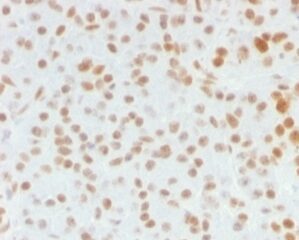ATRX is a member of the Snf2 family of helicase/ATPases, which contribute to the remodeling of the nucelosome structure in an ATP-dependent manner, and facilitate the initiation of transcription and replication. Structurally, ATRX contains a PHD zinc finger motif. ATRX is regulated throughout the cell cycle where it is differentially distributed within the nucleus. During interphase, ATRX predominately associates with the nuclear matrix, while during mitosis, ATRX localizes with condensed chromatin. At the onset of M phase, phosphorylation rapidly induces this redistribution of ATRX to the short arms of human acrocentric chromosomes, where it then specifically complexes with heterochromatin protein 1 α to mediate chromosomal segregation. Mutations in the ATRX gene correlate with a high incidence of severe X-linked form of syndromal mental retardation associated with α thalassaemia or ATRX syndrome.
Clone
39f
Isotype
IgG1k
Host species
Mouse
Species Reactivity
Human
Cellular Localization
nuclus
Positive Control
human brain glioma, fallopian tube, kidney, prostate, stomach, colorectal cancer, cerebellum and hippocampus tissue
Applications
IHC
Intended Use
Research Use Only

